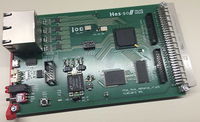Hardware/FPGARack4ethernet
|
This board is a variant of the FPGA rack board, but with 4 Ethernet connectors.
| Type | FPGA Rack | Schematic | UCF | Description |
|---|---|---|---|---|
| V1.0 |  |
FPGA-Rack-Ethernet4 v1.0 Schematic PDF | FPGA-Rack v1.0 UCF Files | There are different FPGA mounted: Spartan 6 XC6SLX45, Spartan 6 XC6SLX100, Spartan 6 XC6SLX150 |
The board is compatible with the FPGA Rack Backplane for interconnecting different boards with the help of the HES-SO Backplane Bus and the HES-SO VME IP Core. It holds 4 Ethernet connectors, each connected to an independent KSZ8041NL PHY.
Ethernet
PHY clocks
All 4 PHYs receive the same 25 MHz clock. This clock signal can be sourced from:
- the quartz oscillator closest to the PHYs (
CLK_PHY_25M) - the FPGA (
CLK_PHY_FPGA, pin AB13).
The FPGA can generate the PHY clock from
- a 106.25 MHz quartz (
CLK_106_25M, pin Y13) - the PHY quartz oscillator (
CLK_PHY_25M, pin AA12) - one of the PHY Rx or Tx clocks (
ETHA_RX_CLK,ETHA_TX_CLK,ETHB_RX_CLK, …)
The last possibility is foreseen to synchronise the clocks of slave Ethernet ports to the one of a master port.
Management Data Input Output (MDIO)
The serial Management Data Input Output (MDIO) interface is connected independently from each PHY to the FPGA.
Serial ports
The FPGA has 3 serial port connections:
- one via an FT232RL RS232 to USB interface (
USB_TXD,USB_RXDand 6 more lines) - 2 via a level translator
- the first goes to a flat cable connector (
UART_TXD0,UART_RXD0) - the second to the JTAG mini connector (
UART_TXD1,UART_RXD01)
- the first goes to a flat cable connector (
USB serial interface
The USB serial interface powers the board
if jumper JP1 is set on the USB_5V side.
It provides a serial port and a JTAG interface. The serial port is connected directly to the FPGA. The JTAG interface can be connected to the FPGA programming lines via zero-Ohm resistors. This programming mode has not been tested yet.
JTAG connector
The HEI 10-pin JTAG connector provides:
- a 3.3 V power supply
- 4 JTAG signals for FPGA and Flash programmation
- a minimal serial port (Rx and Tx)
- 2 FPGA I/O lines